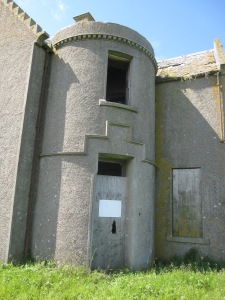The overgrown ruins of the tacksman’s house and Finlay’s home are modest when compared with the gloomy Edwardian mansion which lies close by. Erskine Beveridge built his imposing summer home where he could enjoy spectacular views across the strand to the island of North Uist, and north towards the hills of Harris. But it was much more that simply the scenery which attracted this Fife-based businessman to Vallay.
Erskine Beveridge inherited and expanded his father’s damask linen business in Dunfermline, and made his fortune in the process. He was a keen amateur archaeologist and was very interested in the new art and science of photography. Erskine travelled widely, in Scotland, Europe, America and Canada, but in North Uist he found the ideal location to pursue these two interests of archaeology and photography. He first visited the island in 1897, and bought the island of Vallay in 1901. He then set about building a suitable house for his family – no easy task on a tidal island!
In 1911 Erskine Beveridge published North Uist: Its Archaeology and Topography, the result of his investigations on the island. Today this can be obtained in a reprint. More evidence of his time in North Uist can be found in a book recently published by RCAHMS, Wanderings with a Camera in Scotland. This wonderful book is an invaluable record of the landscape, people and architecture of Scotland in the late 19th and early 20th centuries. The North Uist photos in the collection include pictures of Beveridge’s own excavations in progresss, as well as a mixture of crofting townships and archaeological sites.
Erskine Beveridge died in 1920, and left the house to his son. But his son was tragically drowned crossing the strand in 1944, and Vallay House was soon abandoned. As each winter passes, its exposed position on the edge of the Atlantic must be taking its toll. Much of the roof and many of the floors have collapsed, and the building would be dangerous to enter. Still, there’s enough to be seen through the windows – rich red wall colouring, tiled fireplaces, even a tap – to conjur up an image of Erskine Beveridge, perhaps sitting by that fireside reading over his notes of the day, living his own island dream.
There’s much more to see on Vallay – ruined farm buildings, beautiful beaches, archaeological sites. There wasn’t nearly enough time to see it all before the tide would be rolling in again. Which just means I’ll have to go back ….
© All content copyright Flora Johnston. You may reblog or share with acknowledgement, but please do not use in any other context without permission.










I didn’t know all of this. We’ll have to go back too – and maybe take a tent and spend the night!
The link between Dunfermline and North Uist is an interesting one for us!
I saw Vallay house, through the rain and mist from across the bay, in 2018. It was so mesmerising to me that I researched it’s history. That was in turn so dramatic that it inspired me to write a book; Method of Immortality.
cheers. Tim Malyon.
The tap in your picture is in Erskine’s photography room. There is a scribble with a pencil on the wall from one of the people working there probably to tell a decorator or the like what the room was for.
Pingback: Vallay: ruined houses and a tidal island | Flora Johnston